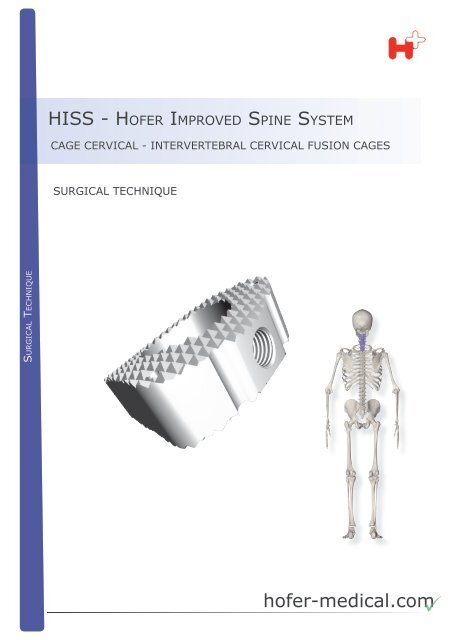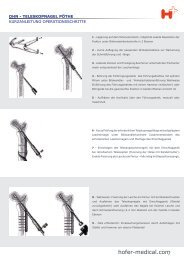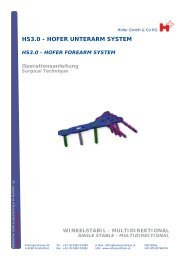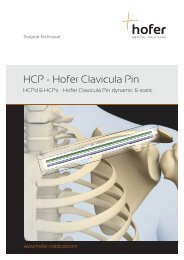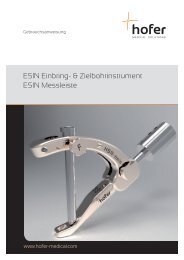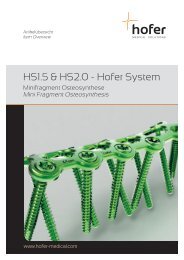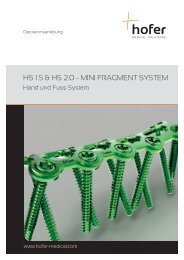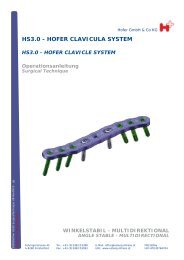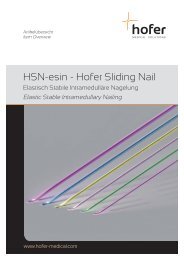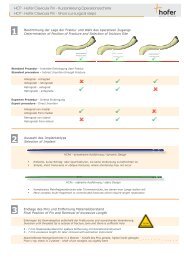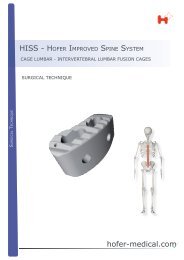hofer-medical.com HISS - HOFER IMPROVED SPINE SYSTEM
hofer-medical.com HISS - HOFER IMPROVED SPINE SYSTEM
hofer-medical.com HISS - HOFER IMPROVED SPINE SYSTEM
Create successful ePaper yourself
Turn your PDF publications into a flip-book with our unique Google optimized e-Paper software.
<strong>HISS</strong> - Hofer Improved Spine SystemCAGE CERVICAL - INTERVERTEBRAL CERVICAL FUSION CAGESSURGICAL TECHNIQUESurgical Technique<strong>hofer</strong>-<strong>medical</strong>.<strong>com</strong>
ContentPreface<strong>HISS</strong>-CC-ST-1Introduction<strong>HISS</strong>-CC-ST-2Implant Specific Information<strong>HISS</strong>-CC-ST-3Indications, Contra IndicationsHIS-CC-ST-3Position of Patient and ApproachesHIS-CC-ST-3Implant Specific DetailsHIS-CC-ST-3Surgical Technique<strong>HISS</strong>-CC-ST-4Preparation and Implant Size Determination<strong>HISS</strong>-CC-ST-4.1Insertion of Implants<strong>HISS</strong>-CC-ST-4.2Finishing Implantation<strong>HISS</strong>-CC-ST-4.3Wound Closure<strong>HISS</strong>-CC-ST-4.4Post-operative Treatment<strong>HISS</strong>-CC-ST-4.5Epilogue<strong>HISS</strong>-CC-ST-5WarningThis description is not sufficient for immediate use of implants and instruments.An instruction into handling these instruments by a surgeon experienced with them is strongly re<strong>com</strong>mended.
IntroductionAll implants for cervical spinal fusion of the <strong>com</strong>pany Hofer GmbH & Co KG (<strong>HOFER</strong>) are conceived for an application inorthopaedics only.The implant provides a temporary load transfer between the affected spinal segments till bony consolidation is achieved.<strong>HISS</strong>-CC-ST-2
Implant Specific Information<strong>HISS</strong> - Cage cervicalIndicationsMultisegmental cervical interbody fusion to treat disc related disorders• Degenerative spinal disorders• Instability• Unsuccessful spondylolisthesisAdditional instrumentation has to be considered according to the situation.Contra Indications• Active systemic infections or local infections around the implantation area• Allergies or contaminant reactions caused by one of the implant materials• Severe osteoporosis• Instable burst or <strong>com</strong>pression fractures• Overweight, osteopenia or degenerative disorders• Destructive tumors• Limiting, since the probability for fusion can be reduced: Radiation- or chemotherapy,renal dialysis• Limiting due to a possible overload leading to a potential implant failure: Toohigh level of activity, limited mental abilities, mental disorders, alcoholism, drugabuse, non-<strong>com</strong>pliance of post-operative instructionsPosition of Patient and ApproachesPatient Positioning:• StandardApproach:• StandardImplant Specific Details• 3 sizes in 1 mm steps for an optimal disc height and lordosis restoration• Toothed upper and lower side for reducing implant migration• Smooth edges• Radiolucent cage material for bone formation determination• X-ray markers for determination of implant position• Large central <strong>com</strong>partment for bone materialX-Ray markersMarks pointing in cranial directionCage size refers to the height of the frontal wall<strong>HISS</strong>-CC-ST-3
Surgical Technique - Preparation, Implant Size Determination4 - Implantation of the <strong>HISS</strong> Cage cervicalPreparatory measures for the use of <strong>HOFER</strong> implants require a preparation as thorough as possible of theoperation field. Nearby nerve fibers and blood vessels require a special caution.4.1 - Preparation and Implant Size Determination4.1.1 - Preparation of Implant Location: Preparation of Disc and EndplatesDistraction may be necessary for a proper access to ensure a thorough discectomy.For a thorough discectomy the application of currettes and rongeurs is re<strong>com</strong>mended. In addition, to remove remainingcartilage and disc material from the bony endplates, a rasp can be used carefully.IMPORTANT: The integrity of the endplates has to be maintained.4.1.2 - Segment DistractionFurther distraction of the disc space prior to cage insertion is achieved by an appropriate distraction set-up.IMPORTANT: An already correct alignment of the segments has to be considered at this stage since the cage size is determinedwithin the next steps.4.1.3 - Determination of Implant SizePrior to the insertion of the implant the required cage size can be determined and verified by a define cage. The definecages are available in the same sizes and variants as the implants.IMPORTANT: The define cages have smooth surfaces and are made of steel. These define cages are not for implantationand have to be removed again!NOTE: The concave endplate shape of the inferior vertebra is considered by the convex upper side of the define cages andcages. Therefore, the total height of the define cages and implantable cages is approximately 1 mm higher than as referedto. For more information refer to the implant specific details on the previous page.Fig. 1: Determination of implant size with define cage<strong>HISS</strong>-CC-ST-4.1
Surgical Technique - Insertion of Implants4.2 - Insertion of Implants4.2.1 - Cage Preparation, Insertion and PositioningPrior to the implantation of the cage it has to be connected to the insertion instrument.For more information on the insertion instrument please refer to:• Instruction manual for handling the insertion instrumentIMPORTANT: Prior to the cage insertion a proper connection with the insertion instrument has to be established. A tooloose or wrong conecction can seriously damage the implant - instrument connection!For an additional check of the correct implant size a special size gauge is available.For the correct handling of the size gauge please refer to:• Instruction manual for handling the size gaugeIf required, fill the cages with bone graft.The cage is now ready for implantation. Insert the cage accordingly to the approach and the preparation of the implantlocation.IMPORTANT: Since the upper side of the cervical cages is convex its proper orientation has to be considered prior to itsinsertion (see the marks on the front side pointing in cranial direction). For more information refer to the implant specificdetails in the previous section.Fig. 2: Insertion direction of for the cage after theremoval of define cageFig. 3: Lateral view to control the final implant position<strong>HISS</strong>-CC-ST-4.2
Surgical Technique - Finishing ImplantationThe design of the insertion instrument also allows some careful manipulation to reach the final position. If necessary theinsertion instrument can also be used as an impactor.IMPORTANT: Too strong impacts or maneuvers can seriously damage the implant - instrument connection!For the correct handling of the insertion instrument as an impactor please refer to:• the respective manualFig. 4: Inserted implant4.3 - Finishing Implantation4.3.1 - Instrument Removal and Verfication of Implant PositionAfter the final position of the implant is achieved the inserting instrument can be disconnected and removed from theimplant.For the correct handling of the insertion instrument please refer to:• Instruction manual for handling the insertion instrumentBy means of an image intensifier the final position of the implant is determined and verfied.4.3.2 - Additional Instrumentation and final CompressionIf necessary an additional instrumentation can follow up.<strong>HISS</strong>-CC-ST-4.3
Surgical Technique - Wound Closure and post-operative Treatment4.4 - Wound Closure4.5- Post-operative TreatmentUnless bony consolidation is achieved a standard post operative treatment plan has to be followed.The directive to the patient to load the implant as little as possible is a crucial factor to reduce clinical problems related tofailure of the implant.<strong>HISS</strong>-CC-ST-4.4 / 4.5
Area for Notices
Epilogue© 2011 Hofer GmbH & Co KG. All rights reserved.Operation Manuals, Handbooks, Handouts and Software are proprietary. Copies, duplicates, translations or conversion ofany form in a whole or only in parts are not allowed without a prior written approval by <strong>HOFER</strong>.Any further rights for the software are specified in the provided licence regulation.The <strong>HOFER</strong> logo is a registered trademark of the Hofer GmbH & Co KG in Austria and other countries.The rights at other brand and product names mentioned in this document lie with its owners and are recognized hereby.The mentioning of products which aren‘t from <strong>HOFER</strong> serves exclusively for information purposes and doesn‘t representadvertisement of any form. <strong>HOFER</strong> doesn‘t take on any liability with regard to the choice, performance or usability ofthe products.The methods specified in this document, modes of operation and the like were carefully checked. If faults or suggestionsfor improvement should stand out, however, despite this examination, then we ask you to inform us about these.The operation method represented here introduces merely a possible method for the indication to be treated. It remainsto the decision of the respective surgeon to hold on to the described surgical technique or to vary it according to therequirements. Direct and indirect damages as well as consequential damages are therefore excluded in every case.Please do not hesitate to contact us for further information.Surgical Technique20111213da_<strong>HISS</strong>_Cages_cervical_Surgical_Technique-ge.inddRev. Dec. 2011<strong>HOFER</strong> GmbH & Co KGHofer GmbH & Co KGFehringerstrasse 45A-8280 Fürstenfeld<strong>HOFER</strong>-<strong>medical</strong>InnovatIve Lösungen für dIetraumatoLogIe - orthopädIe - neurochIrurgIefehrIngerstrasse 45a - 8280 fürstenfeLdteL: +43 (0)3382 53388faX: +43 (0)3382 53093TEL: +43 (0)3382/53388FAX: +43 (0)3382/53093office@<strong>hofer</strong>-<strong>medical</strong>.<strong>com</strong>www.<strong>hofer</strong>-<strong>medical</strong>.<strong>com</strong>office@<strong>hofer</strong>-<strong>medical</strong>.<strong>com</strong>www.<strong>hofer</strong>-<strong>medical</strong>.<strong>com</strong>FN21826yUID ATU30764704


